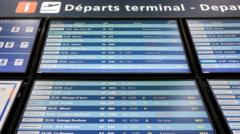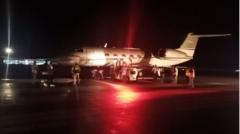The unexpected shutdown of Heathrow Airport has forced hundreds of flights to reroute, stranding passengers and causing a massive scramble for alternative travel arrangements. Experts remark on the complexities involved in rebooking and accommodating those affected.
Heathrow Airport Shutdown Triggers Global Chaos

Heathrow Airport Shutdown Triggers Global Chaos
The sudden closure of London's Heathrow Airport creates a logistical nightmare for airlines and passengers, highlighting the challenges of managing a major travel hub.
March 21, 2025, 6:04 a.m. ET
London's Heathrow Airport, renowned as one of the world's busiest travel hubs, found itself unexpectedly closed early Friday, leaving the travel industry grappling with the fallout. The airport, which handles around 1,300 flights each day for over 80 airlines, saw roughly 120 flights en route when the shutdown occurred.
The immediate impact was profound, as planes already en route had to find alternate landing sites. While some diverted to nearby airports like Gatwick or to farther locations such as Birmingham and Manchester, others were redirected as far as Amsterdam and Frankfurt. A direct flight from New York to Heathrow was forced to land in Reykjavik, Iceland, adding to the ripple effect.
For passengers, the sudden change conjured chaos. Many travelers now found themselves scrambling for hotel accommodations wherever they were rerouted. Airline crews faced mandated rest periods, further complicating operational logistics. Ian Petchenik of Flightradar24 likened the scenario to “a million moving pieces,” illustrating the considerable number of disrupted connections in the aftermath of such a major shutdown.
Officials predict that this unprecedented disruption could extend for several days as airlines work through the backlogs and adjust schedules. The rebooking of possibly hundreds of thousands of affected passengers will take significant time and effort, reminiscent of the disruptions seen during the 2010 volcanic ash crisis that grounded thousands of flights across Europe.
As significant as this event is for those affected, it also marks a crucial point of reflection for the aviation industry on the vulnerabilities of major transport hubs amid unforeseen interruptions.























